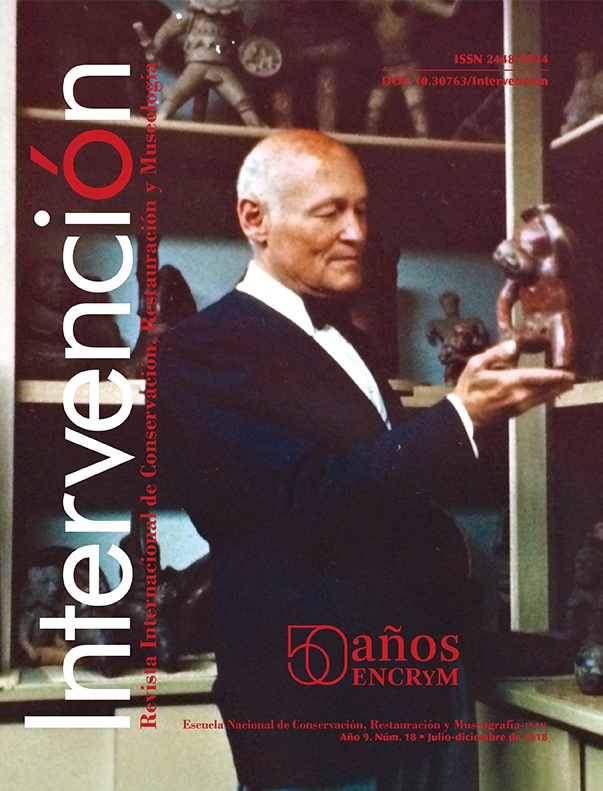A Window-Frame System for the Conservation and Manipulation of Archaeological Textile Fragments
Published 2025-01-21
Keywords
- archaeological textile fragment,
- conservation,
- window-frame,
- manipulation,
- research
- reference collection,
- Chile ...More
Copyright (c) 2018 Instituto Nacional de Antropología e Historia (INAH)

This work is licensed under a Creative Commons Attribution-NonCommercial 4.0 International License.
How to Cite
Abstract
This report presents a new way to address the archaeological textile fragments from the north of Chile. It is based on the study of 16 fragmented pre-Hispanic textiles, in which the lack of information on these pieces was evident, as well as the constant risk of deterioration caused by their manipulation and, therefore, their limitation as object of study. In this context, the Archaeology Laboratory of the National Center for Conservation and Restoration (cncr for its acronym in Spanish) in Chile developed a versatile and low-cost construction called windowframe, which is an efficient tool to safeguard the state of conservation and handling of textile fragments, while increasing their accessibility and availability for research. Such a proposal aims to reclaim the archeological textile fragments as a heritage of great importance, where their contribution is significant as a reference collection.
Downloads
References
- AIC Wiki (2017a). Oddy Test Result: Exhibition Fabrics, American Institute for Conservation of Art and Historic Work (AIC), documento electrónico disponible en [http://www.conservation-wiki.com/wiki/Oddy_Test_Results:_Exhibition_Fabrics], consultado en agosto de 2017.
- ______(2017b) Oddy Test Result: Case Construction Material, American Institute for Conservation of Art and Historic Work (AIC), documento electrónico disponible en [http://www.conservation-wiki.com/wiki/Oddy_Test_Results:_Case_Construction_ Materials], consultado en agosto de 2017. 2017c Oddy Test Result: Exhibition Adhesives and Tapes, American Institute for Conservation of Art and Historic Work (AIC), documento electrónico disponible en [http://www.conservation-wiki.com/wiki/Oddy_Test_Results:_Exhibition_Adhesives_and_Tapes], consultado en agosto de 2017.
- Araya, Carolina, y Mónica Icaza (2016). “Evaluación de la calidad de conservación de materiales de embalaje: una realidad temporal”, Conserva, 21: 25-40.
- Bayer, Anja (2016). “Preserving and Displaying Archaeological Garments Via Pressure Mounting”, en Mary Brooks y Dinah Eastop (eds.), Refashioning and Redress: Conserving and Displaying Dress, Los Ángeles, The Getty Conservation Institute, 79-92.
- Boersma, Foekje, A. Brokerhof, S. van den Berg, y J. Tegelaers (2007). Unravelling Textiles. A Handbook for the Preservation of Textile Collection, Londres, Archetype Publications.
- CCI Notes (2008) [1986]. “Flat Storage for Textiles”, CCI Notes 13/2, serie 13: Textiles and Fibres, documento electrónico disponible en [http://canada.pch.gc.ca/eng/1439925170747], consultado en octubre de 2015.
- ______ (2009) [1986]. “Mounting Small, Light, Flat Textiles”, cci Notes 13/6, serie 13: Textiles and Fibres, documento electrónico dis- ponible en [http://canada.pch.gc.ca/eng/1439925170792], consultado en octubre de 2015.
- ______ (2010). “Conservation Framing of Embroideries and Other Flat Textiles”, cci Notes 13/17, serie 13: Textiles and Fibres, do- cumento electrónico disponible en [http://canada.pch.gc.ca/ eng/1439925170915], consultado en octubre de 2015.
- Comité Nacional de Conservación Textil (2002). Manual de conservación preventiva de textiles, Proyecto Catastro del Patrimonio Textil Chileno, Santiago, Dirección General de Bibliotecas/Fundación Andes.
- Espinoza, Fanny, y Carolina Araya (2000). “Análisis de materiales para ser usados en conservación de textiles”, Conserva (4): 45-55.
- Kajitani, Nobuko y Elena Phipps (2011) [1986]. “A Contact Pressure Mounting System”, en Mary M. Brooks y Dinah Eastop (eds.), Changing Views of Textile Conservation, Los Ángeles, Getty Conservation Institute.
- Lucero, Francisca, y Verónica Díaz (2015). “Técnicas para la conservación de la colección de textiles arqueológicos del Museo de Antofagasta”, Proyecto Regional núm. 45112, Fondos de Cultura 2014, documento electrónico disponible en [http://conservacion-antofagasta. tumblr.com], consultado en junio de 2016.
- National Park Services, Museum Management Program (2001). “Appendix I: Curatorial Care of Archeological Objects”, NPS Museum Handbook, parte I, documento electrónico disponible en [https://www.nps.gov/museum/publications/MHI/AppendI.pdf], consultado en septiembre de 2017.
- ReCollections (2004). Caring for Cultural Material 2, documento electrónico disponible en [https://aiccm.org.au/sites/default/files/docs/re-Collections/2_caring_for_cultural_material_2.pdf], consulta- do en julio de 2016.
- Spicer, Gwen (2016). “Ferrous attractions: the science behind the conservation use of rare-earth magnets”, Journal of the American Institute for Conservation, 55: 96-116.


